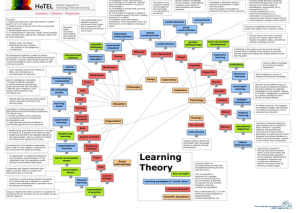Last week, I wrote a post about a first grade lesson I designed using a maker kit called Makey Makey, a computer, and some random materials I bought at a resale shop. The lesson required students to 1) create a new way to play an online game without using their computer keyboards, and 2) to write about the process. The question this week is, “Does learning research support this lesson design?”
We were asked to spend some time looking for articles on learning research in the MSU library database with the caveat that they had to be within the last ten years. I started by checking out the very cool Interactive Learning Theories Map by Richard Millwood:
The learning theories that most support my Makey Makey lesson are those that focus on the learner building his/her own understanding. Some of these listed on the interactive map include Kolb’s experiential learning, the Montessori model, Dewey’s experiental education, Millwood, von Glasersfeld, and Piaget’s constructivism, and Bruner’s discovery learning. Just the fact that so many researchers have advocated for some form of this type of learning over the history of learning research leads you to think that there must be something to it. Bransford, Brown & Cocking (2000) even allude to this type of learning when they say that students must take control of their own learning, and schools and classrooms must be learner-centered. (pp. 3-30). They also state that problem-based learning supports transfer. (Bransford, et al., p. 78).
I decided to take a deeper look at experiential learning through an article by Alice Y. Kolb and David A. Kolb (2005). Although the article discusses experiential learning in the context of higher education, I believe that much of it is equally applicable at the K-12 level. Kolb and Kolb (2005) review experiential learning theory and summarize experiential learning as a recursive process:
Immediate or concrete experiences are the basis for observations and reflections. These reflections are assimilated and distilled into abstract concepts from which new implications for action can be drawn. These implications can be actively tested and serve as guides in creating new experiences. (p. 194).
They then cite research by Zull (2002, p. 18-19) that suggests experiential learning is directly related to how the brain functions. They discuss two comprehensive reviews of Experiential Learning Theory literature and conclude that “ELT has been widely accepted as a useful framework for learning centered educational innovation, including instructional design, curriculum development, and life-long learning.” (Kolb & Kolb, 2005, p. 196).
So my answer to this week’s question is that my Makey Makey lesson contains research-based elements that will promote learning. It is a task that allows learners to make observations based on concrete experiences. They can then reflect on their learning, draw “new implications for action” and then test those implications (by, for example, setting up their Makey Makey input system in a different way). The lesson is interactive, a feature which Bransford, et al. (2000) state is important for learning because it “makes it easy for students to revisit specific parts of the environments to explore them more fully, to test ideas, and to receive feedback.” (p. 209). The interactivity will also, I believe, motivate students to learn and because it is problem-based, students will be more likely to transfer what they learn to other areas.
One concern I have about the lesson is that it may be too much “pure” discovery learning and may not allow my scholars to construct useful knowledge. Richard Mayer (2004) argues against pure discovery learning and in favor of guided discovery, stating, “Students need enough freedom to become cognitively active in the process of sense making, and students need enough guidance so that their cognitive activity results in the construction of useful knowledge.” (p. 16). What useful knowledge do I want my scholars to construct? The way the lesson is currently written, the focus is very much on scientific skills. While these are very important, they are in the end only important if application of the skills leads to understanding of useful knowledge. The specific scientific knowledge accessible from this lesson is an understanding of circuits, and I did not explicitly ever reinforce this concept with the students. Designing and building circuits is a current California 4th grade science standard. Guiding students to begin constructing this knowledge through this lesson will form a basis for that later knowledge. To do this, I revised my lesson plan to add a section explicitly reviewing this knowledge. The changes are in red.
References
Bransford, J.D., Brown, A.L., & Cocking, R.R. (2000). How people learn: Brain, mind, experience and school. National Academies Press. Retrieved from http://www.nap.edu/openbook.php?isbn=0309070368.
Culatta, R. (2013, January 10). Reimagining Learning [Video file]. Retrieved from http://tedxtalks.ted.com/video/Reimagining-Learning-Richard-Cu
Kolb, Alice Y. & Kolb, David A. (2005). Learning Styles and Learning Spaces: Enhancing Experiential Learning in Higher Education. Academy of Management Learning & Education, Vol. 4, No. 2, pp. 193-212.
Mayer, Richard E. (2004). Should There Be a Three-Strikes Rule Against Pure Discovery Learning? – The Case for Guided Methods of Instruction. American Psychologist, Vol. 59, No. 1, pp. 14-19.
Zull, J.E. (2002) The Art of Changing the Brain: Enriching Teaching by Exploring the Biology of Learning. Sterling, VA: Stylus.



